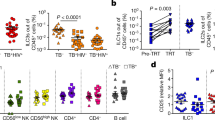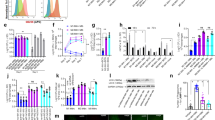Abstract
Toll-like receptor (TLR) signaling in macrophages is required for antipathogen responses, including the biosynthesis of nitric oxide from arginine, and is essential for immunity to Mycobacterium tuberculosis, Toxoplasma gondii and other intracellular pathogens. Here we report a 'loophole' in the TLR pathway that is advantageous to these pathogens. Intracellular pathogens induced expression of the arginine hydrolytic enzyme arginase 1 (Arg1) in mouse macrophages through the TLR pathway. In contrast to diseases dominated by T helper type 2 responses in which Arg1 expression is greatly increased by interleukin 4 and 13 signaling through the transcription factor STAT6, TLR-mediated Arg1 induction was independent of the STAT6 pathway. Specific elimination of Arg1 in macrophages favored host survival during T. gondii infection and decreased lung bacterial load during tuberculosis infection.
This is a preview of subscription content, access via your institution
Access options
Subscribe to this journal
Receive 12 print issues and online access
$209.00 per year
only $17.42 per issue
Buy this article
- Purchase on Springer Link
- Instant access to full article PDF
Prices may be subject to local taxes which are calculated during checkout






Similar content being viewed by others
References
Medzhitov, R. Recognition of microorganisms and activation of the immune response. Nature 449, 819–826 (2007).
Bogdan, C. Nitric oxide and the immune response. Nat. Immunol. 2, 907–916 (2001).
Chan, J., Xing, Y., Magliozzo, R.S. & Bloom, B.R. Killing of virulent Mycobacterium tuberculosis by reactive nitrogen intermediates produced by activated murine macrophages. J. Exp. Med. 175, 1111–1122 (1992).
Thoma-Uszynski, S. et al. Induction of direct antimicrobial activity through mammalian toll-like receptors. Science 291, 1544–1547 (2001).
Brightbill, H.D. et al. Host defense mechanisms triggered by microbial lipoproteins through toll-like receptors. Science 285, 732–736 (1999).
Poole, R.K. Nitric oxide and nitrosative stress tolerance in bacteria. Biochem. Soc. Trans. 33, 176–180 (2005).
Gobert, A.P. et al. Helicobacter pylori arginase inhibits nitric oxide production by eukaryotic cells: a strategy for bacterial survival. Proc. Natl. Acad. Sci. USA 98, 13844–13849 (2001).
Gaur, U. et al. An effect of parasite-encoded arginase on the outcome of murine cutaneous leishmaniasis. J. Immunol. 179, 8446–8453 (2007).
Schnappinger, D. et al. Transcriptional adaptation of Mycobacterium tuberculosis within macrophages: insights into the phagosomal environment. J. Exp. Med. 198, 693–704 (2003).
Davis, A.S. et al. Mechanism of inducible nitric oxide synthase exclusion from mycobacterial phagosomes. PLoS Pathog. 3, e186 (2007).
Talaue, M.T. et al. Arginine homeostasis in J774.1 macrophages in the context of Mycobacterium bovis BCG infection. J. Bacteriol. 188, 4830–4840 (2006).
Bronte, V. & Zanovello, P. Regulation of immune responses by L-arginine metabolism. Nat. Rev. Immunol. 5, 641–654 (2005).
Gordon, S. Alternative activation of macrophages. Nat. Rev. Immunol. 3, 23–35 (2003).
Anthony, R.M., Rutitzky, L.I., Urban, J.F., Jr, Stadecker, M.J. & Gause, W.C. Protective immune mechanisms in helminth infection. Nat. Rev. Immunol. 7, 975–987 (2007).
Wynn, T.A. Fibrotic disease and the T(H)1/T(H)2 paradigm. Nat. Rev. Immunol. 4, 583–594 (2004).
Kim, E.Y. et al. Persistent activation of an innate immune response translates respiratory viral infection into chronic lung disease. Nat. Med. 14, 633–640 (2008).
Rutschman, R. et al. Cutting edge: STAT6-dependent substrate depletion regulates nitric oxide production. J. Immunol. 166, 2173–2177 (2001).
Park, J.H. et al. RICK/RIP2 mediates innate immune responses induced through Nod1 and Nod2 but not TLRs. J. Immunol. 178, 2380–2386 (2007).
Reiling, N. et al. Cutting edge: Toll-like receptor (TLR)2- and TLR4-mediated pathogen recognition in resistance to airborne infection with Mycobacterium tuberculosis. J. Immunol. 169, 3480–3484 (2002).
Gray, M.J., Poljakovic, M., Kepka-Lenhart, D. & Morris, S.M., Jr. Induction of arginase I transcription by IL-4 requires a composite DNA response element for STAT6 and C/EBPbeta. Gene 353, 98–106 (2005).
Pauleau, A.L. et al. Enhancer-mediated control of macrophage-specific arginase I expression. J. Immunol. 172, 7565–7573 (2004).
Vats, D. et al. Oxidative metabolism and PGC-1beta attenuate macrophage-mediated inflammation. Cell Metab. 4, 13–24 (2006).
Bussiere, F.I. et al. Spermine causes loss of innate immune response to Helicobacter pylori by inhibition of inducible nitric-oxide synthase translation. J. Biol. Chem. 280, 2409–2412 (2005).
Gobert, A.P. et al. Helicobacter pylori induces macrophage apoptosis by activation of arginase II. J. Immunol. 168, 4692–4700 (2002).
Zhou, L. et al. An inducible enhancer required for Il12b promoter activity in an insulated chromatin environment. Mol. Cell. Biol. 27, 2698–2712 (2007).
Albina, J.E. et al. Macrophage arginase regulation by CCAAT/enhancer-binding protein beta. Shock 23, 168–172 (2005).
Iyer, R.K. et al. Mouse model for human arginase deficiency. Mol. Cell. Biol. 22, 4491–4498 (2002).
Modolell, M., Corraliza, I.M., Link, F., Soler, G. & Eichmann, K. Reciprocal regulation of the nitric oxide synthase/arginase balance in mouse bone marrow-derived macrophages by TH1 and TH2 cytokines. Eur. J. Immunol. 25, 1101–1104 (1995).
Zea, A.H. et al. Decreased expression of CD3zeta and nuclear transcription factor kappa B in patients with pulmonary tuberculosis: potential mechanisms and reversibility with treatment. J. Infect. Dis. 194, 1385–1393 (2006).
Choi, H.S., Rai, P.R., Chu, H.W., Cool, C. & Chan, E.D. Analysis of nitric oxide synthase and nitrotyrosine expression in human pulmonary tuberculosis. Am. J. Respir. Crit. Care Med. 166, 178–186 (2002).
Scharton-Kersten, T.M., Yap, G., Magram, J. & Sher, A. Inducible nitric oxide is essential for host control of persistent but not acute infection with the intracellular pathogen Toxoplasma gondii. J. Exp. Med. 185, 1261–1273 (1997).
Schluter, D. et al. Inhibition of inducible nitric oxide synthase exacerbates chronic cerebral toxoplasmosis in Toxoplasma gondii-susceptible C57BL/6 mice but does not reactivate the latent disease in T. gondii-resistant BALB/c mice. J. Immunol. 162, 3512–3518 (1999).
Saeij, J.P. et al. Toxoplasma co-opts host gene expression by injection of a polymorphic kinase homologue. Nature 445, 324–327 (2007).
Kerr, A.R., Wei, X.Q., Andrew, P.W. & Mitchell, T.J. Nitric oxide exerts distinct effects in local and systemic infections with Streptococcus pneumoniae. Microb. Pathog. 36, 303–310 (2004).
Sonoki, T. et al. Coinduction of nitric-oxide synthase and arginase I in cultured rat peritoneal macrophages and rat tissues in vivo by lipopolysaccharide. J. Biol. Chem. 272, 3689–3693 (1997).
Karaghiosoff, M. et al. Central role for type I interferons and Tyk2 in lipopolysaccharide-induced endotoxin shock. Nat. Immunol. 4, 471–477 (2003).
Munder, M., Eichmann, K. & Modolell, M. Alternative metabolic states in murine macrophages reflected by the nitric oxide synthase/arginase balance: competitive regulation by CD4+ T cells correlates with Th1/Th2 phenotype. J. Immunol. 160, 5347–5354 (1998).
Munder, M. et al. Th1/Th2-regulated expression of arginase isoforms in murine macrophages and dendritic cells. J. Immunol. 163, 3771–3777 (1999).
El-Gayar, S., Thuring-Nahler, H., Pfeilschifter, J., Rollinghoff, M. & Bogdan, C. Translational control of inducible nitric oxide synthase by IL-13 and arginine availability in inflammatory macrophages. J. Immunol. 171, 4561–4568 (2003).
Di Costanzo, L. et al. Crystal structure of human arginase I at 1.29-A resolution and exploration of inhibition in the immune response. Proc. Natl. Acad. Sci. USA 102, 13058–13063 (2005).
Wanasen, N. & Soong, L. L-arginine metabolism and its impact on host immunity against Leishmania infection. Immunol. Res. 41, 15–25 (2008).
Grode, L. et al. Increased vaccine efficacy against tuberculosis of recombinant Mycobacterium bovis bacille Calmette-Guerin mutants that secrete listeriolysin. J. Clin. Invest. 115, 2472–2479 (2005).
Murray, P.J. The JAK-STAT signaling pathway: input and output integration. J. Immunol. 178, 2623–2629 (2007).
Ryan, J.L., Yohe, W.B. & Morrison, D.C. Stimulation of peritoneal cell arginase by bacterial lipopolysaccharides. Am. J. Pathol. 99, 451–462 (1980).
Igietseme, J.U. et al. Chlamydial infection in inducible nitric oxide synthase knockout mice. Infect. Immun. 66, 1282–1286 (1998).
Rodriguez, N. et al. MyD88-dependent changes in the pulmonary transcriptome after infection with Chlamydia pneumoniae. Physiol Genomics 30, 134–145 (2007).
Lang, R. et al. SOCS3 regulates the plasticity of gp130 signaling. Nat. Immunol. 4, 546–550 (2003).
Gingras, S., Parganas, E., de Pauw, A., Ihle, J.N. & Murray, P.J. Re-examination of the role of suppressor of cytokine signaling 1 (SOCS1) in the regulation of toll-like receptor signaling. J. Biol. Chem. 279, 54702–54707 (2004).
Orihuela, C.J., Gao, G., Francis, K.P., Yu, J. & Tuomanen, E.I. Tissue-specific contributions of pneumococcal virulence factors to pathogenesis. J. Infect. Dis. 190, 1661–1669 (2004).
Cooper, A.M., Pearl, J.E., Brooks, J.V., Ehlers, S. & Orme, I.M. Expression of the nitric oxide synthase 2 gene is not essential for early control of Mycobacterium tuberculosis in the murine lung. Infect. Immun. 68, 6879–6882 (2000).
Acknowledgements
We thank I. Förster (Technical University of Munich) for the LysMcre mice; M. Yanagisawa (University of Texas Southwestern) for the Tie2cre mice; P. Ney (St. Jude Children's Research Hospital) for the CMV-cre mice; D. Green (St. Jude Children's Research Hospital) and S. Akira (Osaka University) for the MyD88-deficient mice; S. Morris (University of Pittsburgh) for the antibodies to Arg1; C. Nathan (Weill Medical School of Cornell University) for the antibody to iNOS; S. Smale (University of California, Los Angeles) for the insulated reporter constructs; D. Bush for nitrotyrosine staining of BCG-infected livers; Xenogen for construction of luciferase-bearing pneumococci; Ozgene for microinjection of the targeted Bruce4 cells into C57BL/6 blastocysts and chimera generation; A. DeFreitas for technical assistance; B. Schulman for discussions and generation of Supplementary Figure 6b; and M. Koyanagi and M. Bix for discussion and preliminary infection experiments. Supported by the Sandler Program for Asthma Research (P.J.M.), the National Institutes of Health (AI062921 to P.J.M.; AI27913 to E.I.T.; AI66046 to G.K.; CORE grant P30 CA21765 and the NIAID intramural research program to T.A.W.), the German Research Foundation (SFB620 project A9 to C.B. and U.S.) and the American Lebanese Syrian Associated Charities.
Author information
Authors and Affiliations
Contributions
K.C.E.K., J.E.Q. and A.M.S. did most of the experiments. J.T.P. and R.W.T. did the T. gondii experiments. M.H.-T., R.J.B., T.K., U.S., M.-S.K., G.K., E.I.T., I.M.O. and C.B. did the infection and biochemistry experiments. K.A.F. and T.-D.K. contributed key research reagents. P.J.M. created the Arg1 conditional knockout. P.J.M. and A.M.S. bred and backcrossed the mice. T.A.W. and P.J.M. conceived and designed the project and wrote the manuscript.
Corresponding authors
Supplementary information
Supplementary Text and Figures
Supplementary Figures 1–10 and Supplementary Methods (PDF 2362 kb)
Rights and permissions
About this article
Cite this article
El Kasmi, K., Qualls, J., Pesce, J. et al. Toll-like receptor–induced arginase 1 in macrophages thwarts effective immunity against intracellular pathogens. Nat Immunol 9, 1399–1406 (2008). https://doi.org/10.1038/ni.1671
Received:
Accepted:
Published:
Issue Date:
DOI: https://doi.org/10.1038/ni.1671
This article is cited by
-
Osteopontin: an essential regulatory protein in idiopathic pulmonary fibrosis
Journal of Molecular Histology (2024)
-
From immunology to artificial intelligence: revolutionizing latent tuberculosis infection diagnosis with machine learning
Military Medical Research (2023)
-
Loss of TRIM24 promotes IL-10 expression via CBP/p300-dependent IFNβ1 transcription during macrophage activation
Inflammation Research (2023)
-
Secreted fungal virulence effector triggers allergic inflammation via TLR4
Nature (2022)
-
Impacts and mechanisms of metabolic reprogramming of tumor microenvironment for immunotherapy in gastric cancer
Cell Death & Disease (2022)



